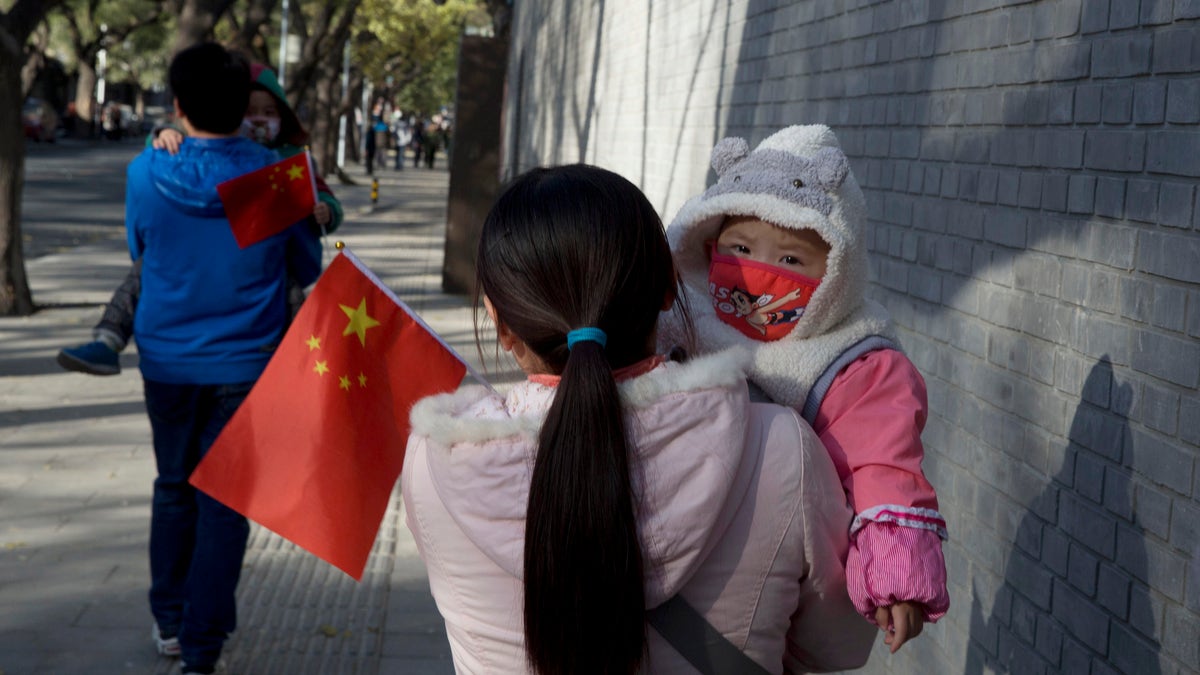
Nov. 16. 2013: Visitors to the forbidden city carry children holding the Chinese national flags in Beijing, China. (AP)
The ripples of China's one-child policy change may be felt as far away as the fields and processing plants of the U.S. farm belt, which has already been shipping a growing share of its soybeans, pork and other products to feed the Asian giant.
Precisely how the further loosening of the three-decade-old population-control policy will affect China's demographics—and by extension, the U.S. growers and agriculture companies—is hard to forecast. China's ruling Communist Party said in a broad blueprint for reform issued Friday that it will allow couples to have two children if one of the parents is an only child, adding to existing exemptions for groups including rural dwellers and some ethnic minorities, as well as couples consisting of two only children. But the impact will depend on how the policy is implemented, and how couples respond.
Still, economists said anything that further grows China's population—which had been projected to peak around 1.4 billion in 2020—is likely to add to demand for U.S. farm goods. In particular, China will need more corn, wheat, soybeans and meal made from the oilseeds to feed the chickens, hogs, cattle and dairy cows it will need to produce to feed its growing population, said Bruce A. Babcock, a professor of economics at Iowa State University in Ames, Iowa.
"More children will mean more dairy products and as those children age, meat consumption will rise," said Dan Kowalski, an economist at Greenwood Village, Colo.-based CoBank, which provides loans, leases and export financing to agribusinesses. "China will not be able to meet all its corn and soybean needs so it will rely on more imports. The U.S. is a prime supplier to China and that trade will become more important as time goes on."
China is forecast to import 7 million metric tons of corn and 69 million tons of soybeans in the marketing year that started on Oct. 1, both records, according to the U.S. Department of Agriculture. Most of that is used to fatten animals consumed by China's burgeoning middle class, which ate 13.5 million tons of chicken and 52.7 million tons of pork, also records, USDA data show. China will import 775,000 tons of pork in 2014, again the most ever.
The country's gross domestic product rose 7.8% in the quarter that ended on Sept. 30 from the same three months a year earlier. Citigroup economists Nathan Sheets and Robert A. Sockin said in an October report that China's "deteriorating demographics," an aging population due to its one-child policy, may trim 3.25 percentage points off China's annual growth rate between 2012 and 2030, compared to its double-digit growth of past decades.
An older population has largely reduced the outlook for China's workforce as many people having children now will soon become less productive as they grow older, said Danny Klinefelter, a professor of agriculture economics at Texas A&M University, in College Station, Texas. To stay competitive, China will need to increase the size of its workforce or face declining productivity, he said. Rising incomes in the country also will boost food consumption, he said.
"Any time you increase population, particularly in country that has ability to buy, then food consumption is going to go up," Mr. Klinefelter said. "Africa has lots of population growth but not the wherewithal to pay for it all. China does."

